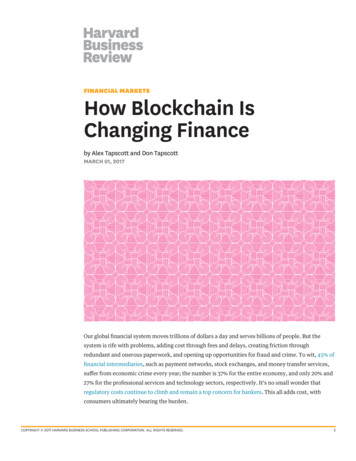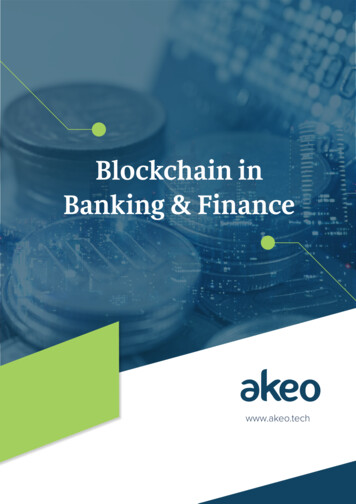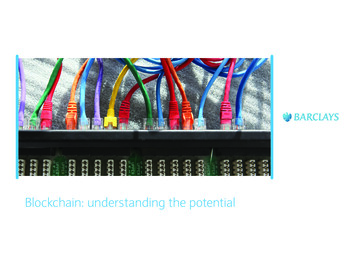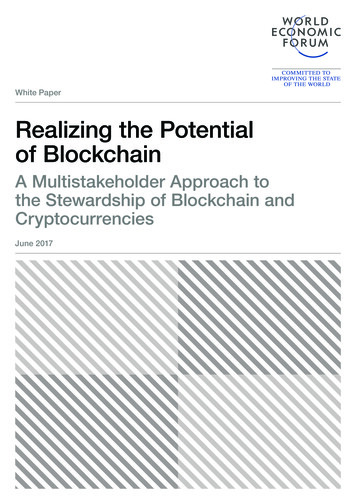
Transcription
FINANCIAL MARKETSHow Blockchain IsChanging Financeby Alex Tapscott and Don TapscottMARCH 01, 2017Our global financial system moves trillions of dollars a day and serves billions of people. But thesystem is rife with problems, adding cost through fees and delays, creating friction throughredundant and onerous paperwork, and opening up opportunities for fraud and crime. To wit, 45% offinancial intermediaries, such as payment networks, stock exchanges, and money transfer services,suffer from economic crime every year; the number is 37% for the entire economy, and only 20% and27% for the professional services and technology sectors, respectively. It’s no small wonder thatregulatory costs continue to climb and remain a top concern for bankers. This all adds cost, withconsumers ultimately bearing the burden.COPYRIGHT 2017 HARVARD BUSINESS SCHOOL PUBLISHING CORPORATION. ALL RIGHTS RESERVED.2
It begs the question: Why is our financial system so inefficient? First, because it’s antiquated, akludge of industrial technologies and paper-based processes dressed up in a digital wrapper. Second,because it’s centralized, which makes it resistant to change and vulnerable to systems failures andattacks. Third, it’s exclusionary, denying billions of people access to basic financial tools. Bankershave largely dodged the sort of creative destruction that, while messy, is critical to economic vitalityand progress. But the solution to this innovation logjam has emerged: blockchain.How Blockchain WorksHere are five basic principles underlying the technology.1. Distributed DatabaseEach party on a blockchain has access to the entire database and its complete history. Nosingle party controls the data or the information. Every party can verify the records of itstransaction partners directly, without an intermediary.2. Peer-to-Peer TransmissionCommunication occurs directly between peers instead of through a central node. Each nodestores and forwards information to all other nodes.3. Transparency with PseudonymityEvery transaction and its associated value are visible to anyone with access to the system. Eachnode, or user, on a blockchain has a unique 30-plus-character alphanumeric address thatidentifies it. Users can choose to remain anonymous or provide proof of their identity to others.Transactions occur between blockchain addresses.4. Irreversibility of RecordsOnce a transaction is entered in the database and the accounts are updated, the recordscannot be altered, because they’re linked to every transaction record that came before them(hence the term “chain”). Various computational algorithms and approaches are deployed toensure that the recording on the database is permanent, chronologically ordered, and availableto all others on the network.5. Computational LogicThe digital nature of the ledger means that blockchain transactions can be tied tocomputational logic and in essence programmed. So users can set up algorithms and rules thatautomatically trigger transactions between nodes.Blockchain was originally developed as the technology behind cryptocurrencies like Bitcoin. A vast,globally distributed ledger running on millions of devices, it is capable of recording anything of value.Money, equities, bonds, titles, deeds, contracts, and virtually all other kinds of assets can be movedand stored securely, privately, and from peer to peer, because trust is established not by powerfulintermediaries like banks and governments, but by network consensus, cryptography, collaboration,COPYRIGHT 2017 HARVARD BUSINESS SCHOOL PUBLISHING CORPORATION. ALL RIGHTS RESERVED.3
and clever code. For the first time in human history, two or more parties, be they businesses orindividuals who may not even know each other, can forge agreements, make transactions, and buildvalue without relying on intermediaries (such as banks, rating agencies, and government bodies suchas the U.S. Department of State) to verify their identities, establish trust, or perform the criticalbusiness logic — contracting, clearing, settling, and record-keeping tasks that are foundational to allforms of commerce.Given the promise and peril of such a disruptive technology, many firms in the financial industry,from banks and insurers to audit and professional service firms, are investing in blockchain solutions.What is driving this deluge of money and interest? Most firms cite opportunities to reduce frictionand costs. After all, most financial intermediaries themselves rely on a dizzying, complex, and costlyarray of intermediaries to run their own operations. Santander, a European bank, put the potentialsavings at 20 billion a year. Capgemini, a consultancy, estimates that consumers could save up to 16 billion in banking and insurance fees each year through blockchain-based applications.To be sure, blockchain may enable incumbents such as JPMorgan Chase, Citigroup, and Credit Suisse,all of which are currently investing in the technology, to do more with less, streamline theirbusinesses, and reduce risk in the process. But while an opportunistic viewpoint is advantageous andoften necessary, it is rarely sufficient. After all, how do you cut cost from a business or market whosestructure has fundamentally changed? Here, blockchain is a real game changer. By reducingtransaction costs among all participants in the economy, blockchain supports models of peer-to-peermass collaboration that could make many of our existing organizational forms redundant.For example, consider how new business ventures access growth capital. Traditionally, companiestarget angel investors in the early stages of a new business, and later look to venture capitalists,eventually culminating in an initial public offering (IPO) on a stock exchange. This industry supportsa number of intermediaries, such as investment bankers, exchange operators, auditors, lawyers, andcrowd-funding platforms (such as Kickstarter and Indiegogo). Blockchain changes the equation byenabling companies of any size to raise money in a peer-to-peer way, through global distributedshare offerings. This new funding mechanism is already transforming the blockchain industry. In2016 blockchain companies raised 400 million from traditional venture investors and nearly 200million through what we call initial coin offerings (ICO rather than IPO). These ICOs aren’t just newcryptocurrencies masquerading as companies. They represent content and digital rights managementplatforms (such as SingularDTV), distributed venture funds (such as the the DAO, for decentralizedautonomous organization), and even new platforms to make investing in ICOs and managing digitalassets easy (such as ICONOMI). There is already a deep pipeline of ICOs this year, such as Cosmos, aunifying technology that will connect every blockchain in the world, which is why it’s been dubbedthe “internet of blockchains.” Others are sure to follow suit. In 2017 we expect that blockchainstartups will raise more funds through ICO than any other means — a historic inflection point.Incumbents are taking notice. The New York–based venture capital firm Union Square Ventures(USV) broadened its investment strategy so that it could buy ICOs directly. Menlo Park ventureCOPYRIGHT 2017 HARVARD BUSINESS SCHOOL PUBLISHING CORPORATION. ALL RIGHTS RESERVED.4
capital firm Andreessen Horowitz joined USV in investing in Polychain Capital, a hedge fund thatonly buys tokens. Blockchain Capital, one of the industry’s largest investors, recently announced thatit would be raising money for its new fund by issuing tokens by ICO, a first for the industry. And, ofcourse, companies such as Goldman Sachs, NASDAQ, Inc., and Intercontinental Exchange, theAmerican holding company that owns the New York Stock Exchange, which dominate the IPO andlisting business, have been among the largest investors in blockchain ventures.As with any radically new business model, ICOs have risks. There is little to no regulatory oversight.Due diligence and disclosures can be scant, and some companies that have issued ICOs have gonebust. Caveat emptor is the watchword, and many of the early backers are more punters than funders.But the genie has been unleashed from the bottle. Done right, ICOs can not only improve theefficiency of raising money, lowering the cost of capital for entrepreneurs and investors, but alsodemocratize participation in global capital markets.If the world of venture capital can change radically in one year, what else can we transform?Blockchain could upend a number of complex intermediate functions in the industry: identity andreputation, moving value (payments and remittances), storing value (savings), lending andborrowing (credit), trading value (marketplaces like stock exchanges), insurance and riskmanagement, and audit and tax functions.Is this the end of banking as we know it? That depends on how incumbents react. Blockchain is notan existential threat to those who embrace the new technology paradigm and disrupt from within.The question is, who in the financial services industry will lead the revolution? Throughout history,leaders of old paradigms have struggled to embrace the new. Why didn’t AT&T launch Skype, or Visacreate Paypal? CNN could have built Twitter, since it is all about the sound bite. GM or Hertz couldhave launched Uber; Marriott could have invented Airbnb. The unstoppable force of blockchaintechnology is barreling down on the infrastructure of modern finance. As with prior paradigm shifts,blockchain will create winners and losers. Personally, we would like the inevitable collision totransform the old money machine into a prosperity platform for all.Alex Tapscott is Founder and CEO of Northwest Passage Ventures, a consultancy, advisory firm and investor in theblockchain industry. He is the coauthor of the book, Blockchain Revolution: How the Technology Behind Bitcoin isChanging Money, Business and the World. Follow him on Twitter @alextapscott.Don Tapscott is the bestselling author of Wikinomics, The Digital Economy, and a dozen other acclaimed books abouttechnology, business and society. According to Thinkers50, Don is the 4th most important living management thinker inthe world; he is an adjunct professor at the Rotman School of Management, and Chancellor of Trent University. He andhis son Alex are co-authors of the book Blockchain Revolution: How the Technology Behind Bitcoin is Changing Money,Business, and the World. Follow him on Twitter @dtapscott.COPYRIGHT 2017 HARVARD BUSINESS SCHOOL PUBLISHING CORPORATION. ALL RIGHTS RESERVED.5
Copyright of Harvard Business Review Digital Articles is the property of Harvard BusinessSchool Publication Corp. and its content may not be copied or emailed to multiple sites orposted to a listserv without the copyright holder's express written permission. However, usersmay print, download, or email articles for individual use.
blockchain industry. He is the coauthor of the book, Blockchain Revolution: How the Technology Behind Bitcoin is Changing Money, Business and the World. Follow him on Twitter @alextapscott. Don Tapscott is the bestselling author of Wikinomics, The Digital Economy, and a dozen othe










